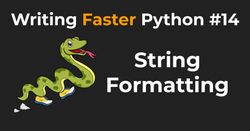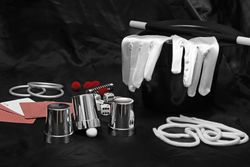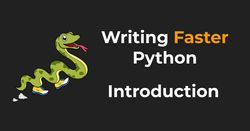Dictionary Comprehension
Apart from the list comprehension method, in Python, we also have dictionary comprehension - a little less known but very useful feature. It's a perfect tool for creating a dictionary from an iterable. Let's see how we can use it and if it's faster than other methods.
About the "Writing Faster Python" series
"Writing Faster Python" is a series of short articles discussing how to solve some common problems with different code structures. I run some benchmarks, discuss the difference between each code snippet, and finish with some personal recommendations.
Are those recommendations going to make your code much faster? Not really.
Is knowing those small differences going to make a slightly better Python programmer? Hopefully!
You can read more about some assumptions I made, the benchmarking setup, and answers to some common questions in the Introduction article. And you can find most of the code examples in this repository.
The simplest way to create a dictionary is to use a for loop:
powers = {}
for n in range(1000):
powers[n] = n * nThat's not super-elegant. We can simplify our code by passing a list of key-value tuples directly to the dict() function:
dict([(n, n * n) for n in range(1000)])Before Python 2.7, this was the simplest way to build a dictionary from an iterable. It's not bad, but all those brackets and parentheses can be slightly confusing.
With the release of Python 2.7.3, PEP 274 introduced dictionary comprehension, which lets us simplify our code even further:
{n: n * n for n in range(1000)}It's certainly much easier to read, but is it faster? Let's look into it.
Dictionary comprehension vs. dict() vs. for loop
Here are the functions that I'm benchmarking:
# dictionary_comprehension.py
NUMBERS = list(range(1000))
def for_loop():
powers = {}
for number in NUMBERS:
powers[number] = number * number
return powers
def dict_from_tuples():
return dict([(n, n * n) for n in NUMBERS])
def dict_comprehension():
return {i: i * i for i in NUMBERS}And here are the results for Python 3.11.0:
# Python 3.11.0
$ python -m timeit -s "from dictionary_comprehension import for_loop" "for_loop()"
10000 loops, best of 5: 32.1 usec per loop
$ python -m timeit -s "from dictionary_comprehension import dict_from_tuples" "dict_from_tuples()"
5000 loops, best of 5: 51.3 usec per loop
$ python -m timeit -s "from dictionary_comprehension import dict_comprehension" "dict_comprehension()"
10000 loops, best of 5: 31.2 usec per loopInteresting! Two things surprised me:
forloop is as fast as dictionary comprehension! I was expecting it to be the slowest function.- Creating a dictionary from a list comprehension is around 60% slower (51.3/31.2≈1.64) than other functions. I expected it to be a bit slower, but not that much.
What happens if we increase the benchmarks to run for more numbers? Let's see:
# dictionary_comprehension.py
MORE_NUMBERS = list(range(1_000_000))
def for_loop2():
powers = {}
for number in MORE_NUMBERS:
powers[number] = number * number
return powers
def dict_from_tuples2():
return dict([(n, n * n) for n in MORE_NUMBERS])
def dict_comprehension2():
return {i: i * i for i in MORE_NUMBERS}$ python -m timeit -s "from dictionary_comprehension import for_loop2" "for_loop2()"
5 loops, best of 5: 44.9 msec per loop
$ python -m timeit -s "from dictionary_comprehension import dict_from_tuples2" "dict_from_tuples2()"
5 loops, best of 5: 77.9 msec per loop
$ python -m timeit -s "from dictionary_comprehension import dict_comprehension2" "dict_comprehension2()"
5 loops, best of 5: 43.5 msec per loopDictionary comprehension and for loop are still equally fast, while dict() is now slightly slower than before (77.9/43/5≈1.79).
I hope I've convinced you by now that dictionary comprehension is one of the best ways to build dictionaries from an iterable. This method is faster than passing a list of tuples to a dict() function. And while it's not really that much faster than a simple for loop, dictionary comprehension is much more readable. Once you understand the syntax, you can immediately see what's happening in that code.
Creating a dictionary from two iterables
What if we want to combine two iterables?
KEYS = list(range(1_000_000))
VALUES = [x * x for x in range(1_000_000)]Above, we have two iterables we want to use as keys and values in a dictionary. We need to zip the iterables together so we can apply dictionary comprehension:
def comprehension_with_zip():
return {key: value for key, value in zip(KEYS, VALUES)}However, here we don't do anything special with key or value. In the initial examples, the value for each key was computed as we were building a dictionary: n: n * n. But now, it's just key: value. In a situation like this, you can pass zipped iterables directly to the dict() function.
def just_zip():
return dict(zip(KEYS, VALUES))Let's see the benchmarks:
$ python -m timeit -s "from dictionary_comprehension import comprehension_with_zip" "comprehension_with_zip()"
10 loops, best of 5: 34 msec per loop
$ python -m timeit -s "from dictionary_comprehension import just_zip" "just_zip()"
10 loops, best of 5: 31.4 msec per loopCalling dict() on zip() directly is slightly faster (34/31.4≈1.08) than using dictionary comprehension. At the same time, it's a bit more concise.
It's very similar to passing an iterable to a list comprehension. In many cases, list comprehension is the best way to create a list, but sometimes you can use an even shorter version if you don't do any processing on the iterable:
# Bad
[x for x in range(1000)]
# Good
list(range(1000))Conclusions
Dictionary comprehension is one of the cleanest ways to build a dictionary. Compared with the old way of passing a list of tuples (in Python 2.6 and below), it's faster and more readable.
But it only makes sense to use it when you compute a key or a value on the fly or if you want to do some filtering. If both the key and the value are ready (for example, they come from two different iterables), simply passing the zip() function to dict() results in a much faster and more readable code:
# Good use case for dictionary comprehension - we compute the value
{i: i * i for i in range(1000)}
# Good use case for dictionary comprehension - we compute the key
{i * i: i for i in range(1000)}
# Good use case for dictionary comprehension - we filter values
{i: i * i for i in range(1000) if i > 50}
# Bad use case for dictionary comprehension
NUMBERS = range(1000)
SQUARES = [x * x for x in range(1000)]
{key: value for key, value in zip(KEYS, VALUES)}
# Use a zip() instead
dict(zip(NUMBERS, SQUARES))

